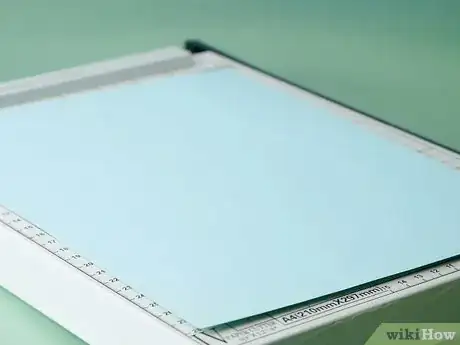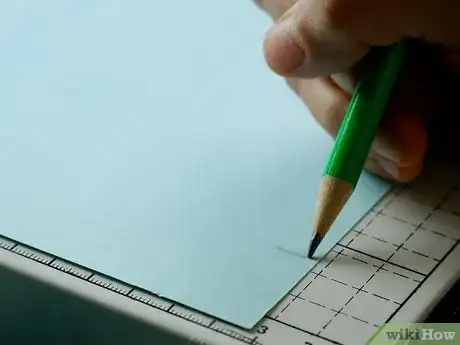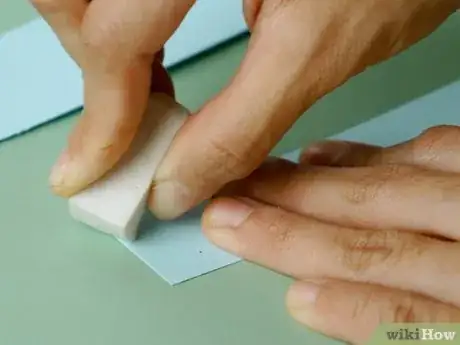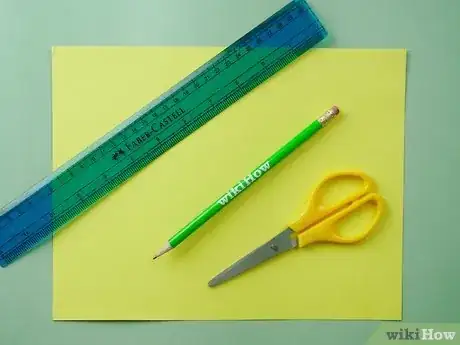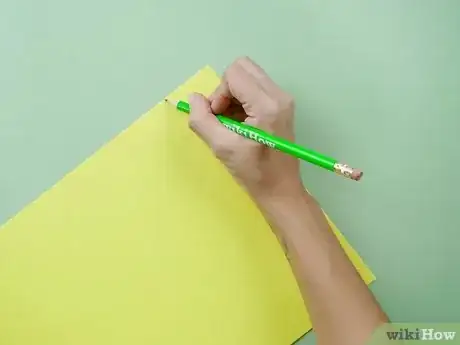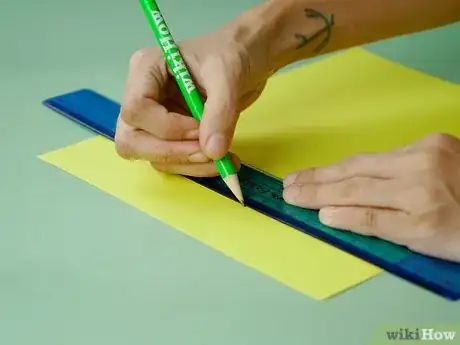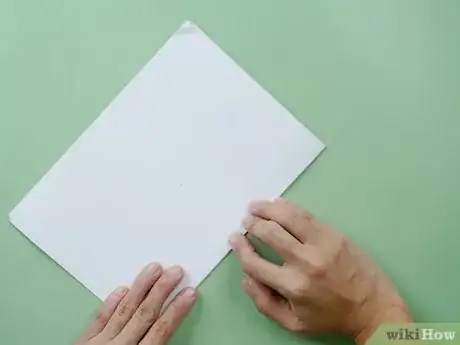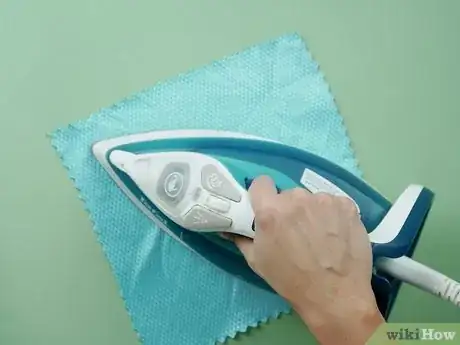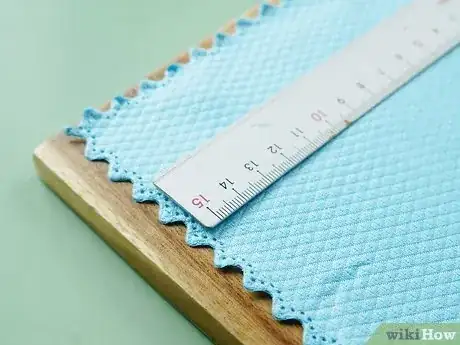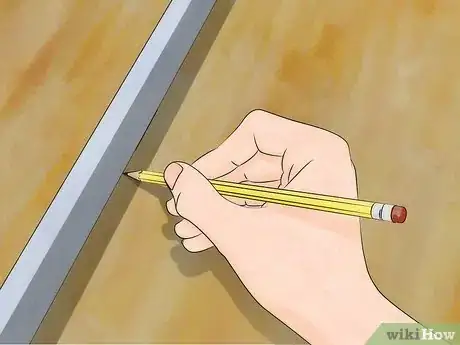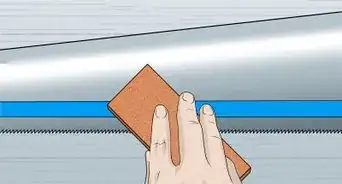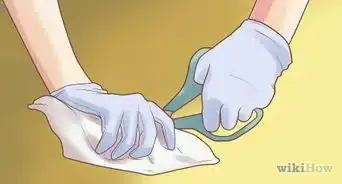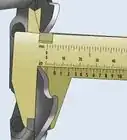This article was co-authored by Amy Guerrero. Amy Guerrero is an Arts and Crafts Specialist and the Owner of Sunshine Craft Co., a crafting studio based in Phoenix, Arizona. Amy specializes in macrame, DIY crafting, and teaching fiber arts. She offers monthly in-person and online workshops along with having developed a range of DIY craft kits for at-home projects. Amy holds a BS in Industrial Design from Philadelphia University. She worked as a graphic designer before starting her own business. Sunshine Craft Co. is a creative hub that offers a wide range of workshops, tools, and resources for any craft project to inspire creativity and community engagement.
This article has been viewed 260,068 times.
Whether you want a perfect square of paper for scrapbooking or you’re making a beautiful quilt, sometimes, a project just needs perfectly straight lines. Everyone hates the moment of realization when you have cut a crooked line along. You can learn to cut straight lines in paper, fabric, and wood with several tools you probably already have around your house.
Steps
Cutting a Straight Line on Paper Using a Craft Knife
-
1Gather your materials. You will need a 12” or longer metal ruler, a pencil, paper, and a craft knife. The process will be easier if you also have a cutting mat: these are widely available at hobby and fabric stores, have straight lines printed on them, and protect working surfaces so that you don’t end up scoring lines in your dining room table. “Sticky tack,” a removable putty-type adhesive, can help anchor the ruler.
- X-ACTO knives are very commonly used by crafters, and are easily found in most craft stores and many superstores. If you don’t have one or don’t want to buy one, a box cutter will also work (as long as it’s sharp).
- If you use a box cutter, straight razor blade, or other extremely sharp object, use extreme caution! Craft knives such as X-ACTO knives have safety handles that can help keep you from cutting yourself. Never allow children to use sharp knives without adult supervision.
-
2Place the paper on a flat surface. If you have a cutting mat, place the paper there. Make sure your work surface doesn’t have any bumps or bubbles, as this will affect your cutting.Advertisement
-
3Use a pencil to mark the start and end of your line. Lightly mark your paper (so you can erase the marks later) with small dots or lines to show the beginning and end of your line.[1]
-
4Place the ruler on the paper. Line up the ruler alongside the marks you made in Step 3 to create a straight line between them.
- If you’re working on patterned paper, such as scrapbooking paper, make sure that the line you’ve created is aligned with the pattern. If your line is straight but askew from the pattern, the final product will look crooked. Adjust the paper as necessary.
- If you have sticky tack, place a small bit on either end of the ruler and press it onto the cutting mat (or work surface). This will anchor the ruler in place so it doesn’t move as you cut.
-
5Hold the ruler in place with one hand while cutting with the other. Press the ruler firmly onto the work surface, or secure it with sticky tack. Place the blade of your knife right alongside the ruler and slice downward, pulling the knife carefully toward you. Repeat a few times to make sure the paper is completely cut through.
- Don’t apply too much pressure with the knife as you cut. This could break the blade or create drag on the paper, making it tear instead of cut neatly.
- You can also cut from side to side, rather than pulling the blade toward you. If you do this, move the blade in the direction of your dominant hand (towards the right if you are right-handed, towards the left if you are left-handed). This will allow you to see what you’re doing.
-
6Erase the pencil marks you made in Step 3. If you can still see the pencil marks, gently erase them. Don’t press too hard on the paper with the eraser or you could tear the paper.
Cutting a Straight Line on Paper Using Scissors
-
1Gather your materials. You will need a pair of sharp scissors (“safety” or children’s scissors won’t work), paper, a pencil, and a metal ruler. A cutting mat and sticky tack will help prevent damage to your work surface and keep the ruler in place.
-
2Place the paper on a flat surface. If you have a cutting mat, place the paper there. Make sure your work surface doesn’t have any bumps or bubbles, as this will affect your cutting.
-
3Use the pencil to mark the beginning and end of your line. Lightly mark with dots or lines where you want your line to start and end. Don’t press too hard or the marks will be difficult to erase later.
-
4Line up the ruler alongside the marks. Place the ruler on the paper about one millimeter below where you want your line to be.
-
5Open your scissors up to the widest point. Be careful when holding open scissors so that you don’t cut yourself. Only grip the top of the blade.
- If you have craft or kitchen shears, they may separate at a center pivot point. If you can separate your blades, this may be easier and safer.
-
6Place the scissors alongside the ruler. Hold the ruler steady with one hand while you cut with the other. Pressing gently into the paper, swipe the blade of the scissors quickly along the ruler. Repeat this motion two or three more times.
- Don’t press too hard with the blade or you could cause too much friction on the paper. This could end up tearing it instead of cutting it neatly.
-
7Cut along the crease you just created. Using the crease you created as a guide, carefully cut along the paper with scissors.
- If you don’t mind rougher edges, you can also tear the paper along the crease. This will give the edges of the paper a “fuzzy” look rather than the sharp line of scissors.
-
8Erase the pencil marks you made in Step 3. If you can still see the pencil marks, gently erase them. Don’t press too hard on the paper with the eraser or you could tear the paper.
Cutting a Straight Line on Paper Using Folding
-
1Gather your materials. All you need for this technique are scissors or a craft knife, paper, and your hands. This technique works best with stiffer paper that will hold a sharp crease.
-
2Fold the paper where you want the cut to be. Place the paper onto a hard surface and press firmly along the fold. The crease needs to be very sharp to provide the best guide for your scissors.
-
3Open the paper and fold it in the opposite direction. Hinge on the fold line so that you are folding the paper in the same spot. Press the paper firmly along the fold again.
-
4Cut along the fold line. You can use scissors or a craft knife to cut along the fold line. Move carefully so that you stay in line with the fold.
Cutting a Straight Line on Fabric Using a Rotary Cutter
-
1Start with smooth, wrinkle-free fabric. Iron your fabric to remove any wrinkles and creases. Wrinkled fabric will cause jaggedness even if you cut a straight line.
- If you're using a fabric like linen or cotton, using spray starch will give your fabric a bit more body and make it easier to cut.[2]
-
2Prepare your cutting area. Place a ruled cutting mat on a flat, level, stable surface with good lighting. A cutting mat will help you cut straight lines in fabric, and it will also prevent damage to your work surface. Cutting mats are easily found at most craft and fabric stores.
-
3Align your fabric on the cutting mat. Use a horizontal line to make sure your fabric is lying straight. Place a metal-edged ruler across the fabric, and line it up along a vertical line on the mat.
-
4Check twice, cut once. Double-check your alignment before you cut your fabric. Once you're satisfied, use a rotary cutter (kind of like a pizza wheel, but for cutting fabric) to cut the fabric along the edge of the ruler.
Cutting a Straight Line on Fabric Using an Iron and Folding
-
1Start with smooth, wrinkle-free fabric. Iron your fabric to remove any wrinkles and creases. Wrinkled fabric will cause jaggedness even if you cut a straight line.
- If you're using a fabric like linen or cotton, using spray starch will give your fabric a bit more body and make it easier to cut.[3]
-
2Place a metal ruler along the fabric where you want to cut. If you have a cutting mat, use the lines on it to help ensure that the ruler is straight.
- If you're cutting fabric that has a definite pattern or direction, make sure your ruler is aligned with the pattern. Depending on the fabric, this may mean you need to slant your line rather than cut a perfectly vertical line that skews the pattern.
- You must use a metal ruler for this step! Plastic rulers will melt once you apply heat.
-
3Fold the fabric over the ruler. If you have a fabric-covered ironing board, pin the fabric to the ironing board to keep it in place. Otherwise, you can just hold it securely with your hand.
-
4Use the iron to press a crease over the ruler. Applying gentle pressure, move the iron back and forth over the fold you just created. The ruler will help you press a perfectly straight crease.
-
5Open up the fabric and cut along the fold. Place the ruler alongside one edge of the fold to help keep your scissors or rotary cutter steady. Cut slowly along the fold.
Cutting a Straight Line in Wood Using a Circular Saw
-
1Create a cutting jig for your saw. This process is fairly simple, and you'll be able to use the jig every time you want to cut a piece of wood.
- Use a sheet of 1/4" plywood as your base. Cut a piece about 10" wide and about 4' long.(If your project is much larger, make the base longer to provide more stability.)
- Cut a piece of 3/4" plywood to form a "fence." The fence should be a few inches wider than the width of your saw's motor and should be as long as your base.
- Align the base and the fence at the ends and one long edge. Use wood glue and screws to glue the base and the fence together.
- Clamp the jig to the edge of a work table. If you don't have one, you can secure a large sheet of plywood to two sawhorses and clamp the jig to the edge of that.
- Align your circular saw with the fence and cut along the base. This will trim any excess and make sure the jig fits your particular saw perfectly.
-
2Use a pencil and a straightedge to mark your line on the wood. Mark the line you want to cut on the back side of the piece of wood: this will keep the front of the wood from splintering.[4]
-
3Place the wood and cutting jig on sawhorses or a work table. Align the cutting jig with the line you just marked. Clamp the jig to the wood.
- Place the "good side" of the wood face-down. Circular saws cut clockwise, which means that most of the splintering happens on the side of the wood facing the blade.[5]
-
4Align your saw with the fence on your jig. Pushing the saw away from you, move the saw steadily and slowly along the jig. You should have a straight cut!
Warnings
- Make sure not to hurt yourself with the scissors. Always keep scissors pointed away from you and from other people, preferably downwards when walking with them.⧼thumbs_response⧽
Things You'll Need
- Metal-edged ruler
- A cutting tool: scissors, a craft knife, a rotary cutter, or a saw
- The material you want to cut: paper, fabric, or wood
- A pencil
- A cutting mat
- sticky tack
References
- ↑ http://makeandtell.com/tips-tricks-cutting-paper-straight/
- ↑ http://www.craftsy.com/article/cutting-techniques
- ↑ http://www.craftsy.com/article/cutting-techniques
- ↑ http://www.bobvila.com/articles/975-how-to-cut-straight-lines-with-a-circular-saw/#.VL1b7kfF-V4
- ↑ http://www.bobvila.com/articles/975-how-to-cut-straight-lines-with-a-circular-saw/#.VL1b7kfF-V4
About This Article
One of the easiest ways to cut a straight line on paper is with a ruler and a craft knife. Lay the paper out on a flat surface, such as a cutting mat. Mark the beginning and ending points of your line on the paper with a pencil, then line up a ruler with the marks and draw a straight line between them. Hold the ruler firmly in place along the line with one hand and cut along it with the other using the craft knife. Start at the far end of the paper and pull the knife toward you, applying gentle pressure as you cut. If you can still see any pencil marks on the paper when you’re done, erase them. To learn how to cut a straight line with a rotary cutter or a circular saw, scroll down!

